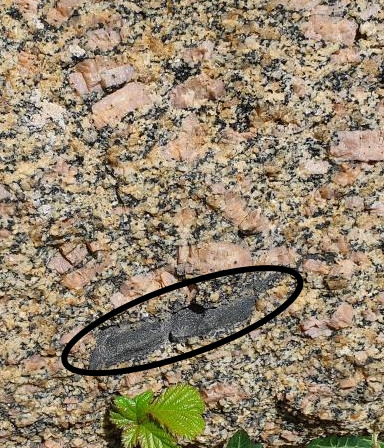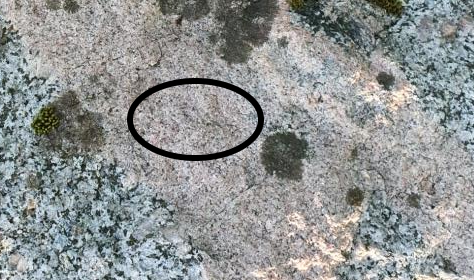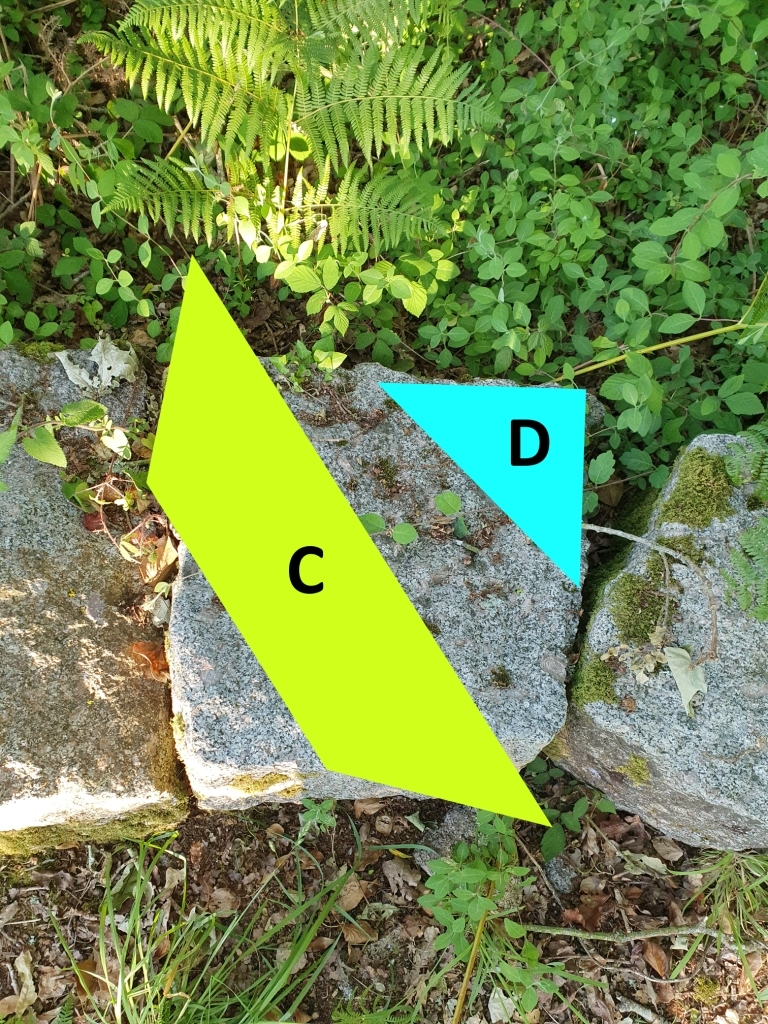Vous vous engagez de votre propre initiative dans la recherche de cette cache à vos risques et périls. Je décline donc toute responsabilité en cas de problème.
Il s'agit d'une Earthcache, il n'y a pas de récipient à chercher.
Carrière Chanter Braz
Le granite de l'Aber Ildut est réputé depuis la Préhistoire puisque de superbes menhirs, comme ceux de Kerloas et de Kergadiou, ont été taillés dans cette roche. La roche affleure aux divers endroits autour de Lanildut et de Porspoder, mais c'est surtout en bordure du rivage et de l'Aber Ildut que l'homme l'a, de tout temps, prélevée pour ses constructions. Diaclasée, elle forme souvent de gros parallélépipèdes favorisant son exploitation. On peut admirer le granite de l'Aber Ildut en se déplaçant parmi les blocs jonchant ce qui reste de l'ancienne carrière, appelée Chanter Braz (le Grand Chantier), abandonnée quelques années avant la Seconde guerre mondiale (vers 1930). Les pierres débitées et taillées sur place sous un hangar étaient ensuite transportées par voie maritime grâce au quai qui fait face à la maison en ruine. De nombreuses gabarres à voiles de la région ont effectué ainsi pendant des années le transport du granite des carrières avoisinantes vers Brest ainsi que vers les ports de Bordeaux, Cherbourg, Le Havre, Rouen, Paris et Dunkerque.

Granite porphyroïde de L’Aber Ildut
Le granite est une roche magmatique, plutonique. Le magma granitique fut injecté il y a environ 300 millions d'années dans une faiblesse de l'écorce terrestre dite de Porspoder. Il est l'un des granites les plus récents en France.
C’est un beau granite porphyroïde principalement rose (avec des teintes différentes allant du rose jusqu’au blanc) avec de fréquentes enclaves sombres (crapauds, xénolithes mélanocrates). Le granite de l'Aber-Ildut se distingue de tous les autres granites bretons par l'abondance de ses feldspaths roses (potassiques), trapus, pluri centimétriques, qui lui donnent un net cachet porphyroïde. Dans un fond à grain moyen où l'on distingue un second feldspath (calco-sodique) blanchâtre, le quartz gris "gros sel" et les innombrables paillettes du mica biotite à vif éclat noirâtre.
Xénolithe
Un xénolithe (du grec ancien xenos et lithos, signifiant "roche étrangère") est une enclave d'une roche incluse dans une roche différente et dont elle n'est pas issue. Le magma granitique pendant qu’il remonte arrache des roches aux formations qu'il traverse. Dans le granit de l’Aber Ildut on trouve fréquemment ces enclaves sombres, appelées crapauds.

Aplite
L'aplite est une roche granitique à grains très fins (cristaux infra-millimétriques), visibles avec une loupe. Les aplites forment des filons (poches ou veines), en bordure ou au voisinage immédiat des plutons granitiques auxquels elles sont génétiquement associées (elles ont une composition voisine). Elles correspondent généralement au liquide résiduel, riche en eau, de fin de cristallisation d'un magma granitique (jus résiduel siliceux). Il est leucocrate, car les minéraux sombres (ferromagnésiens) comme la biotite ont une température de fusion (et donc de cristallisation) beaucoup plus élevé (850 degrés) que les minéraux siliceux (quartz et feldspaths), donc il n'y en pas dans les jus résiduels qui sont les derniers à se solidifier. L'épaisseur des filons est centimétrique, plus rarement décimétrique. À cause de cette granulométrie fine et équidimensionnelle, on peut envisager chez les aplites magmatiques une cristallisation rapide et simultanée.

Mélanocrate et Leucocrate
Mélanocrate et leucocrate sont des adjectifs de coloration de la roche. Une roche leucocrate possède peu, entre 12,5 et 37,5% de ferromagnésiens. Elle est plutôt claire. Les minéraux ferromagnésiens sont sombres, ce sont principalement les micas, les amphiboles, les pyroxènes, les péridots. Par opposition une roche mélanocrate possède beaucoup, entre 62,5 et 87,5% de ferromagnésiens, donc elle est sombre.
Erosion du granite
Sous l'action de l'eau qui ruisselle et s'infiltre dans les fissures (diaclases), les minéraux les plus tendres du granite s'altèrent (biotite et feldspaths). Le quartz, lui, n'est pas altéré. La roche perd alors sa cohérence et se désagrège.
L'érosion différentielle
L'érosion différentielle est la composante d'irrégularité de l'érosion résultant des différences de résistance des matériaux. Elle provoque une mise en relief des zones résistantes au détriment des zones tendres, créant ce qui est appelé des figures d'érosion selon l'échelle considérée : de l'ordre kilométrique comme dans le cas d'une côte rocheuse découpée en anses ou centimétrique comme dans un pavement en mosaïque.
Sources
https://www.patrimoine-iroise.fr/naturel/roches/Kerglonou.php
CHAURIS, Louis. L’article LA SAGA DES GRANITES DE L'ABER-ILDUT a été publié dans le Progrès-Courrier du 8 juillet 1995
Wikipédia
Questions pour valider cette Earthcache :
- Aux coordonnées de la Earthcache regardez la roche devant vous. En vous aidant de la Photo 1 comparez la zone jaune avec la zone orange. Taille de grains, couleur. Pouvez-vous en déduire quelles roches se trouvent sous les deux zones ?
- Quel phénomène pouvez-vous constater en rapport avec l’érosion ? Quels sont les cristaux résistants ?
- Dirigez vous au WP2 vers le front de taille. Pouvez-vous accéder au pied du front de taille ? Estimez sa hauteur.
- Au WP3 trouvez le bloc de granite de la Photo 2. Que pouvez-vous observer sous les zones C et D ? Ces roches sont-elles leucocrates ou mélanocrates ?
- Une photo de vous ou d’un objet vous représentant sur le site.


Loguez cette cache "Found it" et envoyez-moi vos propositions de réponses soit via mon profil, soit via la messagerie geocaching.com (Message Center), et je vous contacterai en cas de problème. Les logs enregistrés sans réponses seront supprimés.
English version
You engage in the search for this cache on your own initiative at your own risk. I therefore decline all responsibility in the event of a problem.
This is an Earthcache, there is no container to look for.
Career Chanter Braz
The granite of Aber Ildut has been famous since Prehistoric times since superb menhirs, such as those of Kerloas and Kergadiou, were carved out of this rock. The rock outcrops in various places around Lanildut and Porspoder, but it is especially along the shore and the Aber Ildut that man has always taken it for his constructions. Diaclassic, it often forms large parallelepipeds favoring its exploitation. You can admire the granite of Aber Ildut by moving among the blocks strewn with what remains of the old quarry, called Chanter Braz (the Great Construction Site), abandoned a few years before the Second World War (around 1930). The stones cut and cut on the spot under a shed were then transported by sea thanks to the quay which faces the ruined house. Numerous sailing vessels in the region have for years transported granite from neighboring quarries to Brest as well as to the ports of Bordeaux, Cherbourg, Le Havre, Rouen, Paris and Dunkerque.
L’Aber Ildut porphyroid granite
Granite is a magmatic, plutonic rock. The granitic magma was injected about 300 million years ago into a weakness in the earth's crust known as Porspoder. It is one of the most recent granites in France.
It is a beautiful, predominantly pink porphyritic granite (with different shades ranging from pink to white) with frequent dark pockets (toads, melanocratic xenolites). Aber-Ildut granite is distinguished from all other Breton granites by the abundance of its pink (potassium), stocky, pluri-centimetric feldspars, which give it a distinct porphyroid character. In a medium-grained background where we can distinguish a second whitish feldspar (sodium-calcium), the gray quartz "coarse salt" and the innumerable flakes of biotite mica with a bright blackish luster.
Xenolith
A xenolith (from the ancient Greek xenos and lithos, meaning "foreign rock") is an enclave of a rock included in a different rock and from which it did not come. The granite magma as it rises tears rocks away from the formations it passes through. In the granite of Aber Ildut one often finds these dark enclaves, called toads.
Aplite
Aplite is a very fine-grained granite rock (infra-millimeter crystals), visible with a magnifying glass. The aplites form veins (pockets or veins), on the edge or in the immediate vicinity of the granitic plutons with which they are genetically associated (they have a similar composition). They generally correspond to the residual liquid, rich in water, at the end of crystallization of a granitic magma (residual siliceous juice). It is leucocratic, because dark minerals (ferromagnesium) like biotite have a much higher melting temperature (and therefore crystallization) (850 degrees) than siliceous minerals (quartz and feldspars), so there is none in the residual juices which are the last to solidify. The thickness of the veins is centimeter, more rarely decimetric. Because of this fine and equidimensional granulometry, one can envisage in the magmatic aplites a rapid and simultaneous crystallization.
Melanocrates and Leucocrates
Melanocrates and Leucocrates are adjectives for rock coloring. A leucocratic rock has little, between 12.5 and 37.5% of ferromagnesium. It is rather clear. Ferromagnesian minerals are dark, they are mainly micas, amphiboles, pyroxenes, peridots. In contrast, a melanocratic rock has a lot, between 62.5 and 87.5% of ferromagnesium, so it is dark.
Erosion of granite
Under the action of the water which runs off and infiltrates the cracks (joints), the softer minerals of the granite deteriorate (biotite and feldspars). Quartz is not altered. The rock then loses its consistency and crumbles.
Differential erosion
Differential erosion is the irregularity component of erosion resulting from differences in material strength. It causes a highlighting of resistant areas to the detriment of soft areas, creating what are called erosion figures depending on the scale considered: in the order of kilometers as in the case of a rocky coast cut into coves or centimeter as in a mosaic pavement
Questions to validate this Earthcache:
1. At the coordinates of the Earthcache, look at the rock in front of you. Using Photo 1, compare the yellow area with the orange area. Grain size, color. Can you deduce which rocks are under the two areas?
2. What phenomenon can you see in relation to erosion? What are resistant crystals?
3. Go to WP2 towards the career outcroff. Can you access near to the outcroff ? Estimate its height.
4. At WP3 find the granite block in Photo 2. What can you observe under areas C and D? Are these rocks leucocratic or melanocratic?
5. A photo of you or an object representing you on the site.
Log this "Found it" cache and send me your suggested answers either via my profile or via geocaching.com messaging (Message Center), and I will contact you in the event of a problem. Logs recorded without response will be deleted.